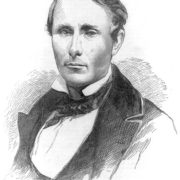Anti-Immigrant Violence 1854
These immigrants were reviled as aliens who didn’t belong in America, strangers who would undermine the American way of life – they were (take a guess) — Irish and German! (Of course, that’s just what you were thinking, correcto?) Violence against these aliens escalated in the mid-19th century, led by the “Know Nothing” anti-immigrant, anti-Catholic party. On October 14, 1854, domestic terrorists from the state of Maine’s “Know Nothing” cell dumped burning tar and feathers over Johannes Bapst. Bapst was a Swiss-born Jesuit missionary and educator who had fought for religious freedom for his parishioners. Despite the horrendous treatment, Bapst did not go back to Switzerland and stayed in his adopted homeland. After a lengthy semi-recovery from the tortuous ordeal, Bapst helped to found Boston College, later becoming its first president. Image of the Bapst Library at Boston College, named in honor of the torture victim, unwanted immigrant, and college president.
Estos inmigrantes fueron vilipendiados como extraterrestres que no pertenecían a Estados Unidos, extraños que socavarían el estilo de vida estadounidense; eran … ¡irlandeses y alemanes! (Por supuesto, eso es justo lo que estabas pensando, ¿correcto?) La violencia contra estos extraterrestres se intensificó a mediados del siglo 19, liderada por el partido antiinmigrante y anticatólico “Know Nothing”. El 14 de octubre de 1854, terroristas domésticos de la célula “No sé nada” del estado de Maine arrojaron alquitrán ardiente y plumas sobre Johannes Bapst. Bapst era un misionero y educador jesuita nacido en Suiza que había luchado por la libertad religiosa de sus feligreses. A pesar del horrendo tratamiento, Bapst no regresó a Suiza y se quedó en su tierra adoptiva. Después de una larga semi-recuperación de la tortuosa experiencia, Bapst ayudó a fundar Boston College, convirtiéndose más tarde en su primer presidente. Imagen de la biblioteca Bapst en Boston College, nombrada en honor a la víctima de la tortura, el inmigrante no deseado y el presidente de la universidad.



